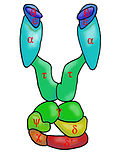DNA polymerase III holoenzyme
DNA polymerase III holoenzyme is the primary enzyme complex involved in DNA replication in Escherichia coli (E. coli) and many other bacteria. It is responsible for the majority of DNA synthesis during cellular replication. The holoenzyme is highly processive, meaning it can synthesize long stretches of DNA without dissociating from the template. Its activity is essential for the accuracy and speed of DNA replication, making it a critical component of the bacterial cell cycle.
Structure[edit]
The DNA polymerase III holoenzyme is a complex structure composed of multiple subunits, each with a specific function. The core of the enzyme consists of three subunits: α, ε, and θ. The α subunit (encoded by the dnaE gene) possesses the polymerase activity, synthesizing new DNA strands. The ε subunit (encoded by the dnaQ gene) has 3'→5' exonuclease activity, which allows for the correction of misincorporated nucleotides, enhancing the fidelity of DNA replication. The θ subunit (encoded by the holE gene) is thought to stabilize the ε subunit and enhance its exonuclease activity.
Surrounding the core is a clamp loader complex, composed of several subunits (τ, γ, δ, δ', and χψ), which is responsible for loading the β clamp (encoded by the dnaN gene) onto DNA. The β clamp is a dimer that encircles the DNA molecule, allowing the core enzyme to slide along the DNA without dissociating, thereby increasing the processivity of DNA synthesis.
Function[edit]
The primary function of DNA polymerase III holoenzyme is to replicate the bacterial genome accurately and efficiently. It achieves this through a series of coordinated steps:
1. **Initiation**: The process begins at the origin of replication, where the DNA is unwound by helicase, creating a replication fork. 2. **Loading of the β clamp**: The clamp loader complex opens the β clamp and places it around the DNA. 3. **Elongation**: The α subunit begins synthesizing the new DNA strand, using the original strand as a template. The β clamp moves with the polymerase, keeping it attached to the DNA. 4. **Proofreading**: The ε subunit proofreads the newly synthesized DNA, excising any incorrectly incorporated nucleotides. 5. **Termination**: Replication continues until the polymerase reaches the termination site, where it dissociates from the DNA.
Regulation[edit]
The activity of DNA polymerase III holoenzyme is tightly regulated to ensure that DNA replication occurs only once per cell cycle. This regulation involves the interaction of the holoenzyme with other proteins, such as DnaA (initiator protein), and the control of the availability of the β clamp and the clamp loader complex.
Clinical Significance[edit]
While DNA polymerase III holoenzyme is specific to bacteria, understanding its function and regulation can inform the development of antibacterial drugs. Inhibitors targeting the unique components of the bacterial replication machinery, such as the β clamp or the clamp loader complex, could provide new avenues for antibiotic development.
See Also[edit]

This article is a molecular biology stub. You can help WikiMD by expanding it!
Ad. Transform your life with W8MD's Budget GLP-1 injections from $75


W8MD offers a medical weight loss program to lose weight in Philadelphia. Our physician-supervised medical weight loss provides:
- Weight loss injections in NYC (generic and brand names):
- Zepbound / Mounjaro, Wegovy / Ozempic, Saxenda
- Most insurances accepted or discounted self-pay rates. We will obtain insurance prior authorizations if needed.
- Generic GLP1 weight loss injections from $75 for the starting dose.
- Also offer prescription weight loss medications including Phentermine, Qsymia, Diethylpropion, Contrave etc.
NYC weight loss doctor appointmentsNYC weight loss doctor appointments
Start your NYC weight loss journey today at our NYC medical weight loss and Philadelphia medical weight loss clinics.
- Call 718-946-5500 to lose weight in NYC or for medical weight loss in Philadelphia 215-676-2334.
- Tags:NYC medical weight loss, Philadelphia lose weight Zepbound NYC, Budget GLP1 weight loss injections, Wegovy Philadelphia, Wegovy NYC, Philadelphia medical weight loss, Brookly weight loss and Wegovy NYC
|
WikiMD's Wellness Encyclopedia |
| Let Food Be Thy Medicine Medicine Thy Food - Hippocrates |
Medical Disclaimer: WikiMD is not a substitute for professional medical advice. The information on WikiMD is provided as an information resource only, may be incorrect, outdated or misleading, and is not to be used or relied on for any diagnostic or treatment purposes. Please consult your health care provider before making any healthcare decisions or for guidance about a specific medical condition. WikiMD expressly disclaims responsibility, and shall have no liability, for any damages, loss, injury, or liability whatsoever suffered as a result of your reliance on the information contained in this site. By visiting this site you agree to the foregoing terms and conditions, which may from time to time be changed or supplemented by WikiMD. If you do not agree to the foregoing terms and conditions, you should not enter or use this site. See full disclaimer.
Credits:Most images are courtesy of Wikimedia commons, and templates, categories Wikipedia, licensed under CC BY SA or similar.
Translate this page: - East Asian
中文,
日本,
한국어,
South Asian
हिन्दी,
தமிழ்,
తెలుగు,
Urdu,
ಕನ್ನಡ,
Southeast Asian
Indonesian,
Vietnamese,
Thai,
မြန်မာဘာသာ,
বাংলা
European
español,
Deutsch,
français,
Greek,
português do Brasil,
polski,
română,
русский,
Nederlands,
norsk,
svenska,
suomi,
Italian
Middle Eastern & African
عربى,
Turkish,
Persian,
Hebrew,
Afrikaans,
isiZulu,
Kiswahili,
Other
Bulgarian,
Hungarian,
Czech,
Swedish,
മലയാളം,
मराठी,
ਪੰਜਾਬੀ,
ગુજરાતી,
Portuguese,
Ukrainian
